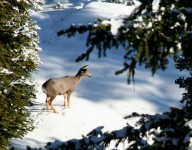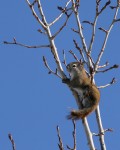Winter can bring a range of snow conditions from minimal snow to deep snow with an icy crust. Whether the snow condition is favorable or not depends on how the animal moves through it or on it.
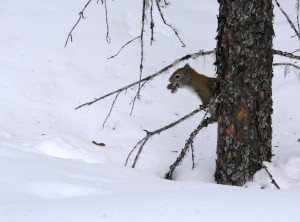
Red squirrels move atop and within the snow. Their tracks can be seen between trees or not at all since they create tunnels within the snow between their nest and cache. The tunnels allows them to travel undetected by predators.
Deep snow can be a disadvantage or an advantage for predators. When deep winter snow arrives, cougars follow deer and elk to lower elevations or southern-facing slopes. Cougars then have the advantage of their prey being concentrated in a smaller area.
Heavy snow on tree branches restricts the arboreal movement of pine martens and squirrels.
Deep snow also causes marten and fishers to shift movement to “first gear” and walk instead of run through their territory. When deep snow hampers movement too much, they tend to hole up and wait for better conditions instead of expending more energy than they would catch in prey.
Wolverines take advantage of deep snow by hunting ungulates. The wolverine’s large feet enable it to travel quicker through the snow than an ungulate’s narrow legs which flounder.
An icy crust can be even more advantageous to certain predators. When the icy crust is thin, it cannot support the weight of ungulates which break through the crust and their legs suffer from the sharp, cutting edges of the ice. Wolverines, coyotes and wolves take advantage of the icy crust to hunt ungulates because they can run on top of the crust.
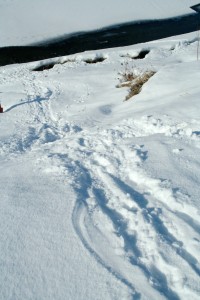
Otters have fun traveling on the snow by tobogganing (sliding) on their bellies and leaving “sled” tracks. They can reach speeds up to 17 mph when running and then sliding.
Martens are able to hunt a larger area with an icy crust because their movement isn’t hampered by bounding through powdery snow.
An icy crust is also advantageous for the smallest animals. A light dusting of snow atop an icy crust reveals tracks of voles, deer mice and other small animals emerging from the subnivean world. They take advantage of the snow’s depth to forage on vegetation they cannot reach in the summer.
The subnivean layer is a melted-out gap between the snow and ground that provides free movement for animals and insulation from cold air temperatures. Voles, deer mice and shrews confine their activity to the subnivean layer when it is cold and snowy because the latent heat from the ground melts the bottom of the snow and creates a more stable air temperature than above the snow. They often create tunnels within the subnivean layer between feeding areas and nests.
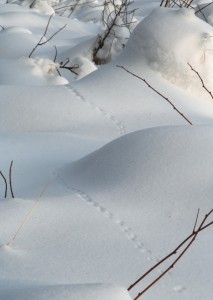
Leaving the subnivean layer to forage or move about on top of the snow exposes small rodents to predators.
These small animals aren’t completely safe from predators in the subnivean world. The small, sinuous body of the ermine allows it to hunt in the subnivean layer where mice, lemmings and voles are active all winter. Marten also plunge below the surface of soft snow to tunnel to these small animals. Coyotes pounce through soft snow to reach the rodents they hear rustling below.
If there isn’t enough snow to create an insulating subnivean layer, the small animals that depend on it can perish because they don’t have enough cover or insulation from the cold temperatures.
The range of snow conditions winter can bestow upon the landscape are handled in different ways by different animals–some prefer deep snow like deer mice and others avoid deep snow like moose. Each winter’s snow pack (or lack of) is sure to make life easier on at least one animal.

